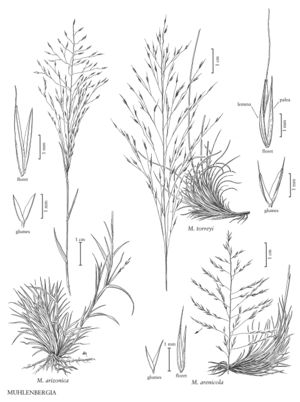Difference between revisions of "Muhlenbergia arizonica"
FNA>Volume Importer |
FNA>Volume Importer |
||
| Line 17: | Line 17: | ||
-->{{Treatment/Body | -->{{Treatment/Body | ||
|distribution=Ariz.;N.Mex. | |distribution=Ariz.;N.Mex. | ||
| − | |discussion=<p>Muhlenbergia arizonica grows in sandy drainages and gravelly canyons, and on plateaus and rocky slopes in open desert grasslands, at elevations of 1220-2230 m. Its range extends from the southwestern United States into northwestern Mexico. Flowering is from August to October.</p> | + | |discussion=<p><i>Muhlenbergia arizonica</i> grows in sandy drainages and gravelly canyons, and on plateaus and rocky slopes in open desert grasslands, at elevations of 1220-2230 m. Its range extends from the southwestern United States into northwestern Mexico. Flowering is from August to October.</p> |
|tables= | |tables= | ||
|references= | |references= | ||
| Line 26: | Line 26: | ||
-->{{#Taxon: | -->{{#Taxon: | ||
name=Muhlenbergia arizonica | name=Muhlenbergia arizonica | ||
| − | |||
|authority=Scribn. | |authority=Scribn. | ||
|rank=species | |rank=species | ||
| Line 33: | Line 32: | ||
|basionyms= | |basionyms= | ||
|family=Poaceae | |family=Poaceae | ||
| − | |illustrator=Linda A. Vorobik | + | |illustrator=Linda A. Vorobik;Annaliese Miller |
| + | |illustration copyright=Utah State University | ||
|distribution=Ariz.;N.Mex. | |distribution=Ariz.;N.Mex. | ||
|reference=None | |reference=None | ||
| Line 39: | Line 39: | ||
|publication year= | |publication year= | ||
|special status= | |special status= | ||
| − | |source xml=https:// | + | |source xml=https://jpend@bitbucket.org/aafc-mbb/fna-data-curation.git/src/f50eec43f223ca0e34566be0b046453a0960e173/coarse_grained_fna_xml/V25/V25_741.xml |
|subfamily=Poaceae subfam. Chloridoideae | |subfamily=Poaceae subfam. Chloridoideae | ||
|tribe=Poaceae tribe Cynodonteae | |tribe=Poaceae tribe Cynodonteae | ||
Revision as of 21:37, 16 December 2019
Plants perennial; cespitose, not rhizomatous. Culms 15-50 cm, erect to decumbent; internodes hispidulous or glabrous below the nodes. Sheaths from slightly shorter to slightly longer than the internodes, rounded to somewhat flattened but not keeled, hispidulous basally, glabrous distally, margins hyaline, not becoming spirally coiled when old; ligules 1-2 mm, hyaline, obtuse, minutely erose; blades 4-7 cm long, 0.8-2 mm wide, flat or folded, glabrous abaxially, scabridulous or hispidulous adaxially, midveins and margins conspicuous, thickened, white, and cartilaginous. Panicles 4-20 cm long, 4-15 cm wide, diffuse; primary branches 0.5-7.5 cm, capillary, diverging 40-90° from the rachises, naked basally; pedicels 2-16 mm, flexuous. Spikelets 2.1-3.1 mm. Glumes equal, 1-1.5 mm, 1-veined, apices scabridulous, obtuse to acute, some¬times minutely erose, unawned; lemmas 2-3.1 mm, elliptic, purplish, appressed-pubescent on the lower 3/4 of the midveins and margins, hairs to 0.6 mm, apices scabrous, acute, minutely bifid, awned, awns 0.5-1.1 mm; paleas 2.1-3.2 mm, elliptic, glabrous, acute; anthers 1.6-2.1 mm, purplish. Caryopses 1.3-1.7 mm, fusiform, sulcate dorsally, brownish. 2n = 20.
Discussion
Muhlenbergia arizonica grows in sandy drainages and gravelly canyons, and on plateaus and rocky slopes in open desert grasslands, at elevations of 1220-2230 m. Its range extends from the southwestern United States into northwestern Mexico. Flowering is from August to October.
Selected References
None.
